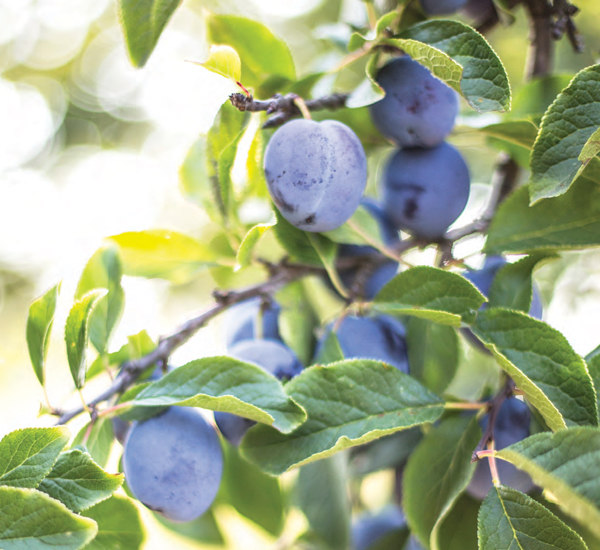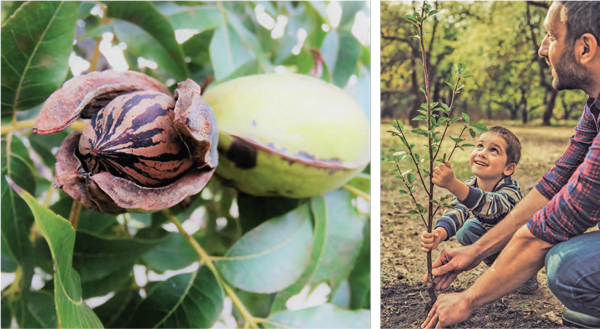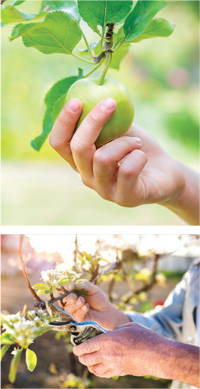Landscaping with Fruit Trees | Add Beauty, Bounty and Value


Imagine walking outside your home and plucking delicious fruit right from a tree just steps away! A great improvement to outdoor space that delivers delightful returns is the addition of fruit trees. Fruit trees can add value to your property and hardy installments in your landscape for generations. Not only can they provide beauty and shade, fruit trees deliver organic, healthy food that you can trust and take pride in cultivating yourself.
Fall and winter are great times to make your landscape plan for the next year—many trees are becoming bare, annuals are dying out and replacement plantings are on your mind. This is a great time to evaluate where you can add fruit trees and other edible plants and shrubs to the landscape plan, and to replace dying or unwanted plantings.

Growing fruit trees requires a bit of planning; consider climate, site selection, tree size and varieties. When choosing fruit trees for your yard, the first consideration is your area’s growing zone: our region of Virginia is located in Zone 7, which means we have the best of both worlds—mainly mild winters and the absence of the long-term, scorching heat found in the deeper south. Some great fruit tree options for our zone are apple trees (Virginia is the 6th largest producer of apples in America); apricot, cherry, fig, nectarine, peach, pear, Asian pear, persimmon and plum trees also flourish in our region.
A next step before planting is to consider the intended site’s soil and sun exposure. Fruit trees require soil that offers good drainage and full sun to thrive. A standard fruit tree grows to be 25-30 feet tall; if yard space is an issue, there are dwarf varieties that only reach about 15 feet and are great for tight spaces. It is also good to remember that fruit trees require commitment and patience; they generally don’t produce fruit until they are three years old and sometimes not until they are five or six. Keeping mature size and fruit production schedule in mind when developing your landscape plan will help alleviate future frustrations.
 Though fruit trees were traditionally relegated to the outer perimeter or back of properties in small family orchards; modern landscaping techniques often incorporate edible landscaping which enhance the aesthetics of a yard. This requires thinking about fruit trees in a different way and integrating them within the landscape plan. If you want trees with vibrant spring flowers, consider a fruiting cherry tree rather than the ornamental variety. Want a shade tree? Consider a pecan rather than an oak, a dwarf apple tree rather than a dogwood. Traditionally, fruit trees were often relegated to the outer perimeter or back of the property as a small family orchard; however, modern landscaping techniques often consider edible landscaping without sacrificing the aesthetics of your yard. This requires thinking about fruit trees in a different way and integrating them within the landscape plan.
Though fruit trees were traditionally relegated to the outer perimeter or back of properties in small family orchards; modern landscaping techniques often incorporate edible landscaping which enhance the aesthetics of a yard. This requires thinking about fruit trees in a different way and integrating them within the landscape plan. If you want trees with vibrant spring flowers, consider a fruiting cherry tree rather than the ornamental variety. Want a shade tree? Consider a pecan rather than an oak, a dwarf apple tree rather than a dogwood. Traditionally, fruit trees were often relegated to the outer perimeter or back of the property as a small family orchard; however, modern landscaping techniques often consider edible landscaping without sacrificing the aesthetics of your yard. This requires thinking about fruit trees in a different way and integrating them within the landscape plan.
Lance Moore, ISA Certified Arborist and owner/operator of Mills Associated Arborists in southwest Virginia often suggests using an espalier technique with fruit trees for clients who have small landscape areas or terraced yards. Moore explains, “Espalier is a practice of pruning and tying fruit tree branches to a frame for space-saving growth and ease of harvesting fruit, which also offers a beautiful decorative aspect to your space.” While this technique was made popular in the Middle Ages to grow fruit alongside castle walls, it is still commonly implemented in modern times in our region, most commonly with pear and apple trees. “A great side benefit to planting fruit trees in this manner,” he adds, “is that the sun more easily reaches the foliage, increasing the quality and quantity of fruit that ripens compared to a traditional fruit tree planting.”
An additional consideration for planting a fruit tree is whether you need to plant a pollinator; you will if the tree you choose is not a self-pollinating variety. Apple trees, for example, generally require another apple or crabapple tree nearby for pollination. Cross-pollinators do not have to be of the same variety, just the same species. If you have close neighbors, perhaps they have a tree of the same species; if so, cross-pollination can occur across the property line without additional investment.
Pruning fruit trees is necessary—not only to maintain trees’ aesthetic, but also to ensure that they remain healthy and productive. Lane Dellinger, ISA Certified Arborist and Landscape Management Professional at Southern Landscape Group in central Virginia offers the following advice: “Pruning of fruit trees is performed to improve fruit quality and size, regulate tree growth and maintain tree size, as well as help reduce production costs.” Pruning activities are normally performed during the dormant season, but young trees can tolerate summer pruning for structure and training purposes prior to fruit-bearing years. “A couple of things to remember,” Dellinger adds: “Pruning reduces fruit yield but invigorates shoot growth; heading and thinning cuts are the two pruning cuts used for fruit trees. Limb position and orientation have an impact on the vigor and fruit-bearing capabilities of the limb; it is best to avoid excessive removal of limbs and shoots. Less is better in most circumstances.”
Adding fruit trees to your property will likely attract additional animals and pests in search of food and habitat. Measures will need to be taken to eradicate these pests in a manner that is safe for humans and pets; remember that trees that are properly planted, watered, and fertilized have the best chances to resist pests and diseases.
Dellinger offers this advice to reduce pests and diseases in fruit trees, “Cultural practices can greatly reduce pest and disease incidence in your fruit trees.” He explains, “These simple steps are a great start: choose a sustainable location for your tree so that critical air and light can penetrate the crown of the trees; prune out and destroy any dead or diseased limbs; rake and burn any fallen fruit tree leaves. Finally remove and destroy dropped and mummified fruit remaining in or under the tree.”
While there are a variety of natural and organic pesticide treatments on the market, specific treatments are dependent upon the particular type of pest or vermin and the type of tree affected. The Virginia Cooperative Extension (VCE) office is an excellent educational source for local tree and plant research, planting and pruning techniques and pest and disease eradication. The VCE is built on a partnership with Virginia’s two land grant universities— Virginia Tech and Virginia State University—and offers a wealth of knowledge for horticultural and planting practices. VCE offers divisions in each city and provides educational resources, seminars, and a wealth of location-based information. Be sure to check out their website at ext.vt.edu to find an office near you. ✦
Arborist, Fruit trees, garden, growing zone, ISA Certified Arborist, landscaping, pruning, Virginia Cooperative Extension (VCE), Virginia State University, Virginia Tech, Zone 7






